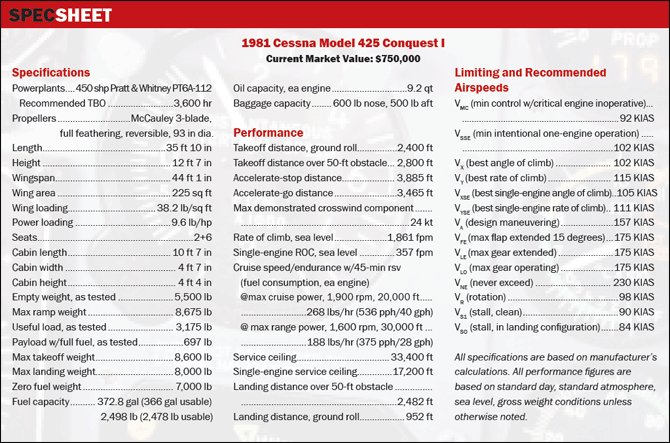Gentlemans Choice: Cessna Conquest I
An easy-to-fly and reliable step-up turboprop
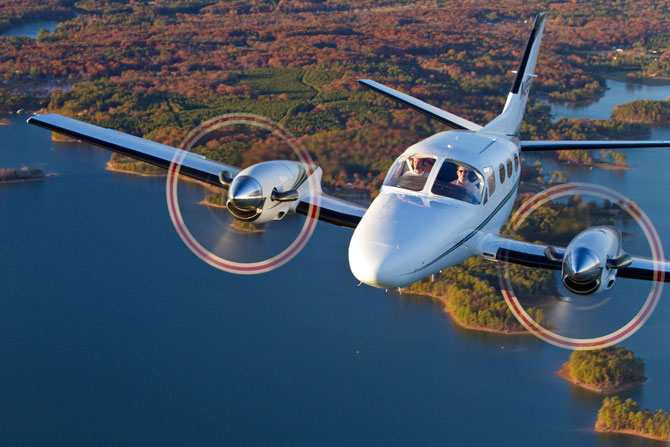
Photography by Mike Fizer
Cessna’s Conquest I is one of the easiest transitions to turbine power for any multiengine, instrument-rated pilot. The airplane is born of the 400-series line of twin Cessnas, known for its easygoing flight manners, comfortable cabin, and generous baggage bins. It is an ideal turboprop for an individual or small company with the need to transport as many as six passengers at 250 knots as far as 800 nm.
The Model 425 Conquest I, dimensionally, is the size of a 421C Golden Eagle. But the similarities between the Golden Eagle piston twin and the Conquest mostly end there. The Conquest is powered by two 450-shaft-horsepower Pratt & Whitney PT6s instead of 375-horsepower geared Continental piston engines. Plus, the 425 is substantially beefed up and utilizes more robust systems. Early versions of the 425 were called Corsairs until a max takeoff weight increase to 8,600 pounds preceded a move by Cessna to call it the Conquest I. All 425s have been converted to the higher-gross-weight configuration of the Conquest I. The Model 441 Conquest, a larger model powered by Honeywell (Garrett) turboprops, was actually introduced first in model year 1978. It was then renamed Conquest II after the Corsair was renamed Conquest I. Cessna built 236 Conquest Is between 1981 and 1986.
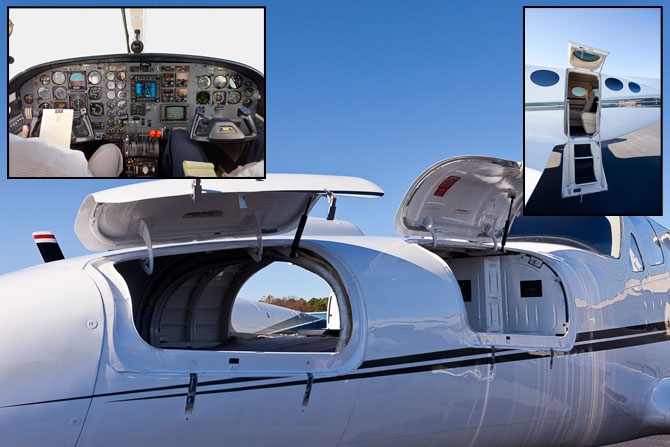
The Conquest I's instrument panel (inset left) is well laid out and has room for anything a pilot desires. Like many legacy turboprops, the panel is a mix of old and new technology. Cockpit visibility is excellent as well. One of the 425's best assets is the massive nose baggage compartment (top) that can swallow golf clubs, skis, and other awkward cargo, totaling as much as 600 pounds. The nose can be accessed by three doors to facilitate easy loading of awkward items. Protocol for many Conquest pilots is to lock the doors whenever they are closed, for added protection against inadvertent openings in flight.
Eagle Aviation of Columbia, South Carolina, granted AOPA Pilot the use of its Conquest I for the photos you see on these pages. N425EA is a 1981 model, which was originally a Corsair. Eagle uses N425EA on the company’s Part 135 charter certificate. Full-fuel payload of N425EA is 697 pounds (no crew), or four people and no bags. Tanks-full range is approximately 1,200 miles. With six adults, range would fall to about 700 nm with reserves.
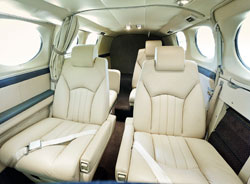 It can be awkward for pilots who just secured the cabin door to squeeze up the aisle after all the passengers are seated. Once everyone is seated, however, the 425 is a comfortable ride. Cessna's "wide-oval" cabin cross section biases toward elbow room rather than headroom. The side-facing seat in the rear doubles as a potty.
It can be awkward for pilots who just secured the cabin door to squeeze up the aisle after all the passengers are seated. Once everyone is seated, however, the 425 is a comfortable ride. Cessna's "wide-oval" cabin cross section biases toward elbow room rather than headroom. The side-facing seat in the rear doubles as a potty.
The 425’s cockpit is laid out well and has excellent visibility. Most Conquest cabin seats are arranged in a four-place club with two additional seats in the back, one of which is a side-facing belted potty. Cessna’s “wide oval” cabin biases more toward elbow room than cabin height. Once seated, it’s a comfortable ride for those in back.
Baggage loading is a snap with the giant nose baggage bin accessible by three doors. It can swallow skis, golf clubs, and other awkward cargo as heavy as 600 pounds. The aft baggage area holds 500 pounds in the pressurized cabin. Unlike the piston-powered 400-series Cessnas, there are no wing lockers.
Competition for the Conquest comes from many fronts. Among the legacy twins, the Piper Cheyenne and Beechcraft King Air C90 provide similarly priced multiengine competition. The C90 is a little slower and pricier than the Conquest, but it has a bigger cabin and more useful load. The Cheyenne IA, II, and IIXL are similar in size and price but a tad slower, depending on the model. On the single-engine side, there’s the Socata TBM series, which promises faster speeds on significantly less fuel, but load carrying suffers. Small jets like the Eclipse, Phenom 100, and Cessna Citation Mustang also make worthy—but far more expensive—competitors.
Blackhawk Modifications Inc. holds STCs to modify the Conquest I, as well as its Beech and Piper competitors, with PT6 engines that maintain their rated power to much higher altitudes. In all of these airplanes, owners can expect about a 20-knot increase in cruise speeds above 18,000 feet and better climb performance. N425EA is outfitted with the Blackhawk engines and handily outperforms any stock Conquest.
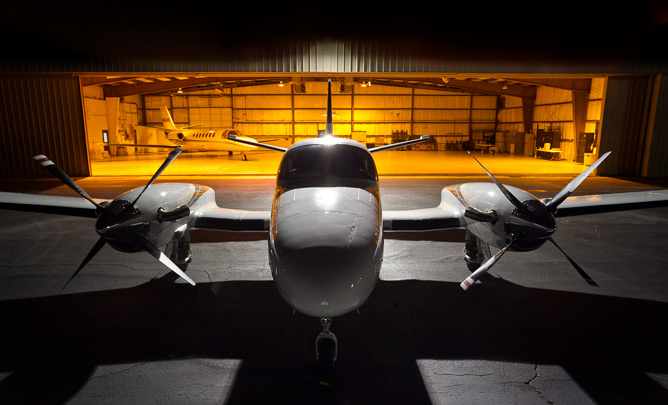
Unlike the piston-powered Cessna 421, the Conquest I has a significant dihedral built into the horizontal stabilizer. Since the stabilizer is within the propwash, once power is pulled off for landing, much of the airflow over the tail stops—making landings challenging for the unaccustomed.
Our test flight loaded three adults, 2,000 pounds of fuel, and some photo-graphy equipment aboard Eagle Aviation’s Conquest—about 500 pounds short of maximum takeoff weight. Like most piston airplanes and their required magneto checks, the Conquest pilot has to check the autofeather system prior to flight.
On a slightly warmer than standard day, our takeoff roll required about 12 seconds to reach rotation speed of 100 knots. Initial climb rate was about 2,000 fpm. ATC cooperated by giving us a direct climb to FL250, which was reached just 18 minutes from brake release—something a stock Conquest could only dream of doing. Along the way, the engines reached their critical altitude (the point at which they become temperature limited as opposed to torque limited) at approximately 22,000 feet—about 4,000 feet higher than the stock engines. In fact, on our test flight, the power levers hit the stops before the engines reached the temp limit. With the Blackhawk engines, climb rates of 1,000 fpm or better are possible well into the flight levels.
We topped out at 270 KTAS at a density altitude of 25,600 feet, which is about 20 knots faster than the stock airplane at that altitude. Fuel burn was just under 500 pounds per hour or about 72 gph. Cabin altitude was just more than 9,000 feet, meaning flight above FL260 may require supplemental oxygen. Most 425s are not RVSM approved, so FL280 would be the limit anyway. Pulling the props back to 1,700 rpm reduces noise and fuel burn while sacrificing a little speed.
What owners have to say
Montreal businessman Jean Delangis stepped up from a Cessna 414A piston to the 425. “From a reliability standpoint, there’s no comparison between the two airplanes,” said Delangis. “It was definitely worth the added cost of the turbines.” Delangis owned the Conquest for 10 years and used it for business and family trips. In those 10 years, he could think of only two delays he took for maintenance items, and the longer delay was one hour.
Aircraft Spruce and Specialty Co. President Jim Irwin worked his way up the Cessna single and twin lines to a 425. “The Conquest has been a reliable, high-performance, cross-country aircraft that has exceeded my expectations in every way,” said Irwin. He flew the airplane with the stock engines and the American Aviation Speed Stacks for about 1,100 hours before doing the Blackhawk conversion. “True airspeed in the flight levels with the stock engines was about 250 KTAS,” said Irwin. At 3,700 hours and in need of new engines, Irwin asked around and heard nothing but good things about the Blackhawk conversion. He took the plunge and retained the airplane’s original, lighter three-blade propellers.
“Climb after takeoff is now 2,000 fpm and since higher power settings can be maintained during climb without reaching ITT temperature limits, the aircraft continues to maintain respectable climb performance through the flight levels,” says Irwin. “I plan for a fuel flow of 500 pounds for the first hour and 400 pounds per hour thereafter. Most flights are made at FL200 to FL250, and sometimes higher for long trips or to top weather. Cruise speed with the Blackhawk conversion is 265 KTAS. The aircraft is easy to fly, reliable, comfortable for passengers, and plenty fast for the missions we fly.” —PAB
Descending in the Conquest is a piece of cake. If needed, just pull the power to idle and push the nose over. If you were late on an ATC crossing restriction, you could probably still make it in a Conquest, which can see 5,000 feet per minute in the descent.Flaps and gear can be deployed at 175 KIAS, which makes keeping up with the flow at major airports easy. It also will fly slowly. With power on at a light operating weight, N425EA flew confidently at 75 KIAS with the gear and flaps extended.
On landing, fly the Conquest right down to the runway and flare just slightly, as it is pitch sensitive in ground effect. The Pratts’ power comes off unevenly in the flare, leading to some last-second footwork to keep the nose pointed down the runway. With the four-blade props especially, when power is pulled to idle and the blades go flat, the airplane slows down very quickly. This also blanks some airflow over the tail, requiring a little extra nose-up pitch at that moment. With experience, Conquest pilots learn to anticipate all these last-second corrections. If not, the beefy, trailing-link gear will likely smooth out your arrival. With effective reverse thrust, Conquests can get into short strips that they can’t get out of, so plan accordingly. At sea level with a full load, plan on runway lengths of 4,000 feet or more—or 3,000 feet when light.
Conquest Is have a short list of warts specific to the design. It’s a fun airplane to hand fly, but changes in power and airspeed require trimming of pitch and yaw to keep the airplane flying straight. The stock torque gauges are notorious for headaches if air is introduced to the wet-line system. Many have been swapped for digital versions that eliminate the problem. The retractable landing lights, which look just like those on a Cessna 195, cause airframe rumble when they are extended at speeds over about 200 KIAS. This also reduces bulb life. Many owners use a self-imposed speed limit of 175 KIAS for the lights, since that speed coincides with the limit speeds for gear operation and the first notch of flaps. The electric motors that power the lights up and down often quit as well. Overall, the 425 is a poorly lit airplane on the exterior. Late-model-year 425s are equipped with beacon lights as well as wing-tip recognition lights as a marked improvement.
The split flaps are of little or no value when it comes to takeoff performance, leading some prospective buyers to the King Air, which can use its more effective flaps on takeoff. Finally, because of the strong resemblance to piston-powered twin Cessnas, 425 owners need to be mindful their airplanes are fueled with Jet-A, not avgas.
For an airplane no longer in production, the Conquest is well supported from the factory and several shops around the country. And if you’ve never owned a turboprop, prepare for some significant costs. TBO of the PT6A is 3,600 hours, and owners typically budget about $200,000 each for overhaul. Hot-section inspections occur at 1,800 hours and ring in around $20,000 each. A Supplemental Inspection Document requiring heavy inspections for aging turboprops affects the Conquest I. It’s a massive job requiring removal of the wings and tail to inspect the attach fittings and look for corrosion. The big task has been reported to cost in the $200,000 range. Whether the airplane has been through this inspection can greatly affect its value.
Blackhawk’s aforementioned conversion costs $610,000 and installs new PT6A-135A engines in exchange for your old -112s. There are credits for unused hours toward TBO of the trade-in engines. Digital torque gauges add $10,000 to the bill. Blackhawk converted six Conquests in 2011 and claims to have modified more than 20 percent of the fleet.
 Eagle Aviation's Conquest I is equipped with PT6A-135 engines installed under Blackhawk's STC. It can maintain takeoff power into the low 20s, greatly increasing speed on high-altitude flights. The Conquest I has split flaps, which create only drag, not lift—so it's possible for the 425 to get into runways it can't get out of. American Aviation's Speed Stacks (above) pull triple duty by looking good, keeping exhaust soot off of the airplane, and adding a few knots.
Eagle Aviation's Conquest I is equipped with PT6A-135 engines installed under Blackhawk's STC. It can maintain takeoff power into the low 20s, greatly increasing speed on high-altitude flights. The Conquest I has split flaps, which create only drag, not lift—so it's possible for the 425 to get into runways it can't get out of. American Aviation's Speed Stacks (above) pull triple duty by looking good, keeping exhaust soot off of the airplane, and adding a few knots.
American Aviation’s Speed Stacks exhaust stacks do triple duty of adding a few knots to the cruise speed, keeping exhaust soot off the airplane, and are more aesthetically pleasing compared to the stock exhaust stacks.
SimCom Training Centers offers 425 training at Orlando, Florida; Scotts-dale, Arizona; and Dallas-Fort Worth, Texas. The DFW location has a Level 6 FTD (flight training device) with full motion while the other locations use fixed-base simulators. Initial training ranges from $5,820 to $8,320, depending on which simulator you choose. Recurrent courses range from $3,520 to $5,260.
While the costs may be daunting, owning a turboprop such as a Conquest brings added safety, performance, and reliability to their owners (see “What Owners Have to Say,” sidebar).
Legacy airplanes that are beyond 30 years of age prove their value to hundreds of owners every day. And until there are suitable new airplanes to replace them, airplanes such as the Conquest will remain valuable machines.
Pete Bedell is a first officer for a major airline and co-owner of a Cessna 172 and Beechcraft Baron.
